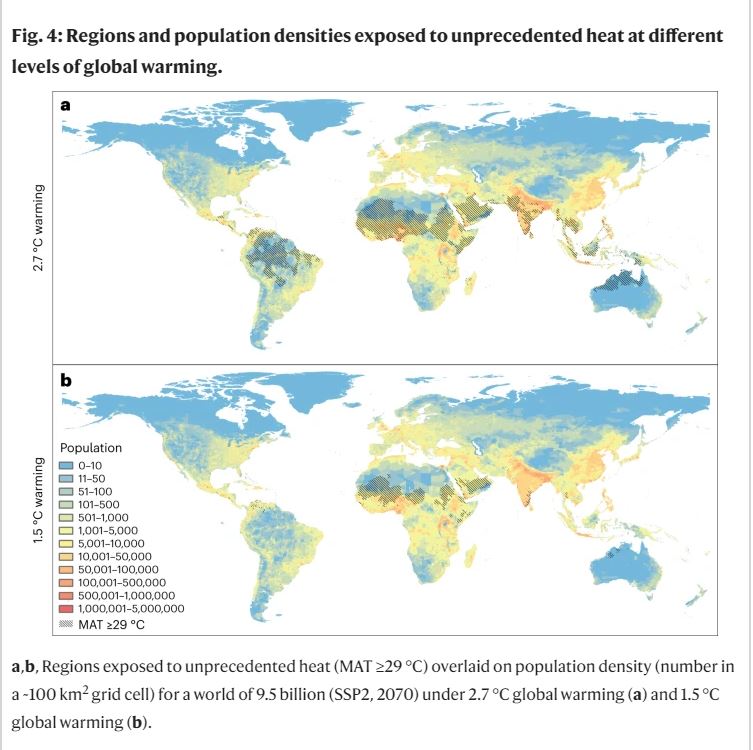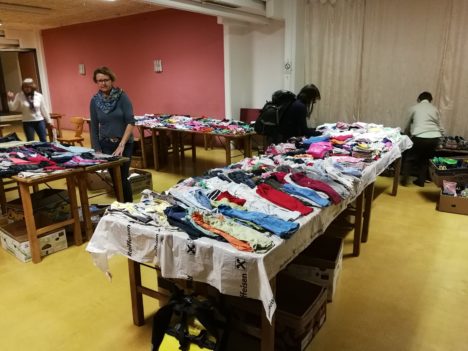Original post by bea on May 27, 2023. Translated by Lisa Scheer in 2023/24.
Disclaimer: Some of the links in this post might redirect you to a site in German. Feel free to use Machine Translation (such as DeepL or Google Translate) to get the information provided on these sites.
The habitability of planet Earth will change fundamentally
The expression „climate niche“ appears more and more frequently. It also appeared in a new study conducted by Exeter University that was published in the journal „Nature Sustainability“. Each creature has an ecological niche with the according temperatures, not only animals, but people too. If temperatures rise by 2.7 degrees compared to the pre-industrial age, a third of the world’s population (3 to 9 billion people) could live out of the „human climate niche“ in extremely difficult circumstances by the end of this century (2080 – 2100). This scenario is the most likely at the moment due to the current weak climate policies.
What even is the human climate niche?
The human climate niche defines the range of temperatures in which humans live preferably. In these temperatures, livestock can be kept, plants can grow and there is enough water and food, but also economic output is possible. Most people live in regions with an average temperature between six and 28 degrees Celsius. These regions inhabitable by people will become less and less due to climate change. They will have to live where it is too hot, too dry or too unstable. They might have to flee and leave their home.
The cost of climate change has thus far only been indicated in monetary sums. This mainly favours the rich, because they have more money to lose and favours future costs less. Climate change threatens all of our lives and health. That’s why each person should be regarded the same. It doesn’t matter if rich or poor, living or still unborn. How high is the human cost of climate change and who pays for it?
If our climate rises by 2.7 degrees, a third of people will live in almost inhabitable climate zones.
At the moment, with a rise in temperatures of around 1.2 degrees, around 600 million people (9% of the Earth’s population) live outside their climate niche. At the current rate of a probable rise of 2.7 degrees compared to pre-industrial times, a third of the total population will lose their habitat. If we can slow down the heating, such as suggested in the Paris Agreement, to only 1.5 degrees, it will not be 33% of the population but only 14%.

Where will living conditions become more difficult?
Countries, such as India, Nigeria and Indonesia, as well as hot and humid regions near the equator, such as Brazil, are especially threatened. In high humidity, our bodies cannot cool themselves down by evaporating sweat on our skin. A small change in temperature in these regions can be life-threatening. This study also shows inequality in climate change. It’s the countries and people that suffer the most which have contributed particularly little to emissions.
Heat is not the only risk
A rise in temperatures of more than 2.7 degrees cannot be ruled out because of insufficient climate policies and the non-stop use of fossil fuels. This could lead to half the population having to live in areas that are outside of our climate niche. Heat becomes more and more of a health risk. A life outside the human climate niche causes more illnesses and a higher risk of death. It will evidently lead to a massive escape movement.
But also inside the climate niche, living conditions are destroyed through climate change. Be it through drought and the creation of deserts or though floods or the rise of sea levels.
Positive aspects?
Each 0.3 degrees less of global warming means 350 million fewer people affected.
Sources:
- Lenton, T.M., Xu, C., Abrams, J.F. et al. Quantifying the human cost of global warming. Nat Sustain (2023). https://www.nature.com/articles/s41893-023-01132-6 [22.5.2023]
- https://www.diepresse.com/6290976/klimawandel-bringt-jedem-dritten-menschen-unmenschliche-temperaturen
- https://science.orf.at/stories/3219420/
- https://www.mdr.de/wissen/klima/klima-update-neunzig-klimanische-weltbevoelkerung-bewohnbare-gebiete-100.html
- https://www.mdr.de/wissen/klimamodell-drittel-der-weltbevoelkerung-lebt-zweitausendeinhundert-ausserhalb-der-klimanische100.html
- https://www.derstandard.at/story/2000146603713/welche-teile-der-erde-in-100-jahren-unbewohnbar-sein-werden
- https://www.salzburg24.at/news/welt/klimawandel-drittel-der-weltbevoelkerung-drohen-unmenschliche-temperaturen-139158502
Anmerkung der NiG-Redaktion:
Falls du keine wichtigen Beiträge oder Termine von uns verpassen willst, abonnier doch bitte gerne unseren Newsletter! Er kommt unregelmäßig und nicht zu häufig – versprochen. Oder schau regelmäßig in unseren Veranstaltungskalender.
Wenn dir gefällt, was wir auf dieser Plattform tun, nämlich bereits seit 2017 über Nachhaltigkeit, Umwelt- und Klimaschutz zu informieren, dann unterstütz uns doch bitte auch finanziell, um unsere Website in dieser Qualität und Fülle weiterführen zu können – uns hilft jeder Beitrag!
Verein „Nachhaltig in Graz“
BIC: STSPAT2GXXX
IBAN: AT20 2081 5000 4200 1552
Verwendungszweck: Spende/Sponsoring (Mehr zum Sponsoring hier)
Du kannst dir auch gerne unsere kostenlose App aufs Handy laden, damit kannst du Informationen, Veranstaltungen und vieles mehr entdecken: App Nachhaltig in Graz














